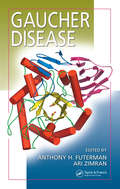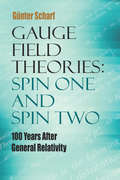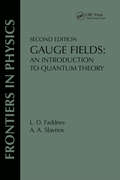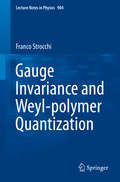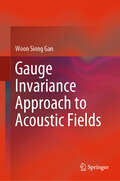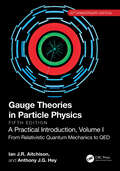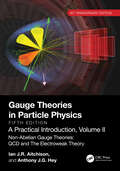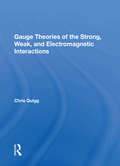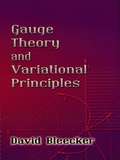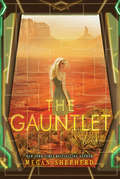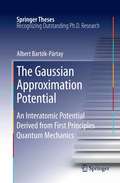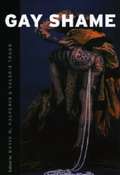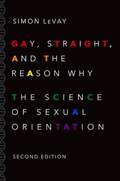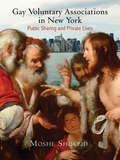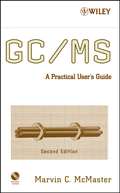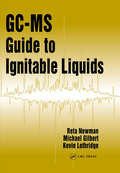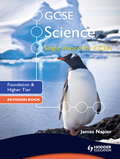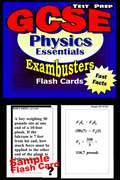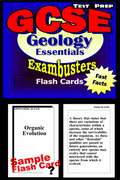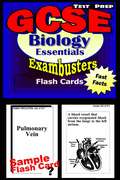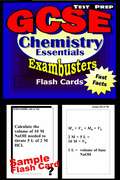- Table View
- List View
Gator or Croc?
by Allan FowlerFrom friendly dolphins to giant pandas, from icebergs and glaciers to energy from the sun, from magnets to solids, liquids, and gases, Rookie Read-About Science is a natural addition to the primary-grade classroom with books that cover every part of the science curricula. Includes: animals, nature, scientific principles, the environment, weather, and much more!
Gaucher Disease
by Anthony H. Futerman Ari ZimranIn September of 2007 Gaucher Disease received a commendation in the Haematology category of the 2007 British Medical Association Medical Book Competition!Although rare in the general population, Gaucher disease is the most prevalent of the lysosomal storage disorders, making research into this particular orphan disorder an invaluable proto
Gauge Field Theories: 100 Years After General Relativity
by Gunter ScharfOne of the main problems of theoretical physics concerns the unification of gravity with quantum theory. This monograph examines unification by means of the appropriate formulation of quantum gauge invariance. Suitable for advanced undergraduates and graduate students of physics, the treatment requires a basic knowledge of quantum mechanics.Opening chapters introduce the free quantum fields and prepare the field for the gauge structure, describing the inductive construction of the time-ordered products by causal perturbation theory. The analysis of causal gauge invariance follows, with considerations of massless and massive spin-1 gauge fields. Succeeding chapters explore the construction of spin-2 gauge theories, concluding with an examination of nongeometric general relativity that offers an innovate approach to gravity and cosmology.
Gauge Fields: An Introduction To Quantum Theory, Second Edition (Frontiers in Physics #Vol. 50)
by L. D. FaddeevFirst Published in 2018. Routledge is an imprint of Taylor & Francis, an Informa company.
Gauge/Gravity Duality: Foundations and Applications
by Martin Ammon Johanna ErdmengerGauge/gravity duality creates new links between quantum theory and gravity. It has led to new concepts in mathematics and physics, and provides new tools to solve problems in many areas of theoretical physics. This book is the first textbook on this important topic, enabling graduate students and researchers in string theory and particle, nuclear and condensed matter physics to get acquainted with the subject. Focusing on the fundamental aspects as well as on the applications, this textbook guides readers through a thorough explanation of the central concepts of gauge/gravity duality. For the AdS/CFT correspondence, it explains in detail how string theory provides the conjectured map. Generalisations to less symmetric cases of gauge/gravity duality and their applications are then presented, in particular to finite temperature and density, hydrodynamics, QCD-like theories, the quark-gluon plasma and condensed matter systems. The textbook features a large number of exercises, with solutions available online at www. cambridge. org/9781107010345.
Gauge Invariance and Weyl-polymer Quantization
by Franco StrocchiThe book gives an introduction to Weyl non-regular quantization suitable for the description of physically interesting quantum systems, where the traditional Dirac-Heisenberg quantization is not applicable. The latter implicitly assumes that the canonical variables describe observables, entailing necessarily the regularity of their exponentials (Weyl operators). However, in physically interesting cases -- typically in the presence of a gauge symmetry -- non-observable canonical variables are introduced for the description of the states, namely of the relevant representations of the observable algebra. In general, a gauge invariant ground state defines a non-regular representation of the gauge dependent Weyl operators, providing a mathematically consistent treatment of familiar quantum systems -- such as the electron in a periodic potential (Bloch electron), the Quantum Hall electron, or the quantum particle on a circle -- where the gauge transformations are, respectively, the lattice translations, the magnetic translations and the rotations of 2π. Relevant examples are also provided by quantum gauge field theory models, in particular by the temporal gauge of Quantum Electrodynamics, avoiding the conflict between the Gauss law constraint and the Dirac-Heisenberg canonical quantization. The same applies to Quantum Chromodynamics, where the non-regular quantization of the temporal gauge provides a simple solution of the U(1) problem and a simple link between the vacuum structure and the topology of the gauge group. Last but not least, Weyl non-regular quantization is briefly discussed from the perspective of the so-called polymer representations proposed for Loop Quantum Gravity in connection with diffeomorphism invariant vacuum states.
Gauge Invariance Approach to Acoustic Fields
by Woon Siong GanThis book highlights the symmetry properties of acoustic fields and describes the gauge invariance approach, which can be used to reveal those properties. Symmetry is the key theoretical framework of metamaterials, as has been demonstrated by the successful fabrication of acoustical metamaterials. The book first provides the necessary theoretical background, which includes the covariant derivative, the vector potential, and invariance in coordinate transformation. This is followed by descriptions of global gauge invariance (isotropy), and of local gauge invariance (anisotropy). Sections on time reversal symmetry, reflection invariance, and invariance of finite amplitude waves round out the coverage.
Gauge/String Duality, Hot QCD and Heavy Ion Collisions
by Jorge Casalderrey-Solana Hong Liu David Mateos Krishna Rajagopal Urs Achim WiedemannHeavy ion collision experiments recreating the quark-gluon plasma that filled the microseconds-old universe have established that it is a nearly perfect liquid that flows with such minimal dissipation that it cannot be seen as made of particles. String theory provides a powerful toolbox for studying matter with such properties. This book provides a comprehensive introduction to gauge/string duality and its applications to the study of the thermal and transport properties of quark-gluon plasma, the dynamics of how it forms, the hydrodynamics of how it flows, and its response to probes including jets and quarkonium mesons. Calculations are discussed in the context of data from RHIC and LHC and results from finite temperature lattice QCD. The book is an ideal reference for students and researchers in string theory, quantum field theory, quantum many-body physics, heavy ion physics and lattice QCD.
Gauge Theories in Particle Physics, 40th Anniversary Edition: From Relativistic Quantum Mechanics to QED, Fifth Edition
by Anthony J.G. Hey Ian J AitchisonThe fifth edition of this well-established, highly regarded two-volume set continues to provide a fundamental introduction to advanced particle physics while incorporating substantial new experimental results, especially in the areas of Higgs and top sector physics, as well as CP violation and neutrino oscillations. It offers an accessible and practical introduction to the three gauge theories comprising the Standard Model of particle physics: quantum electrodynamics (QED), quantum chromodynamics (QCD), and the Glashow-Salam-Weinberg (GSW) electroweak theory.Volume 1 of this updated edition provides a broad introduction to the first of these theories, QED. The book begins with self-contained presentations of relativistic quantum mechanics and electromagnetism as a gauge theory. Lorentz transformations, discrete symmetries, and Majorana fermions are covered. A unique feature is the elementary introduction to quantum field theory, leading in easy stages to covariant perturbation theory and Feynman graphs, thereby establishing a firm foundation for the formal and conceptual framework upon which the subsequent development of the three quantum gauge field theories of the Standard Model is based. Detailed tree-level calculations of physical processes in QED are presented, followed by an elementary treatment of one-loop renormalization of a model scalar field theory, and then by the realistic case of QED. The text includes updates on nucleon structure functions and the status of QED, in particular the precision tests provided by the anomalous magnetic moments of the electron and muon.The authors discuss the main conceptual points of the theory, detail many practical calculations of physical quantities from first principles, and compare these quantitative predictions with experimental results, helping readers improve both their calculation skills and physical insight.Each volume should serve as a valuable handbook for students and researchers in advanced particle physics looking for an introduction to the Standard Model of particle physics.
Gauge Theories in Particle Physics, 40th Anniversary Edition: Non-Abelian Gauge Theories: QCD and The Electroweak Theory, Fifth Edition
by Anthony J.G. Hey Ian J AitchisonThe fifth edition of this well-established, highly regarded two-volume set continues to provide a fundamental introduction to advanced particle physics while incorporating substantial new experimental results, especially in the areas of Higgs and top sector physics, as well as CP violation and neutrino oscillations. It offers an accessible and practical introduction to the three gauge theories comprising the Standard Model of particle physics: quantum electrodynamics (QED), quantum chromodynamics (QCD), and the Glashow-Salam-Weinberg (GSW) electroweak theory.Volume 2 of this updated edition covers the two non-Abelian gauge theories of QCD and the GSW theory. A distinctive feature is the extended treatment of two crucial theoretical tools: spontaneous symmetry breaking and the renormalization group. The underlying physics of these is elucidated by parallel discussions of examples from condensed matter systems: superfluidity and superconductivity, and critical phenomena. This new edition includes updates to jet algorithms, lattice field theory, CP violation and the CKM matrix, and neutrino physics.New to the fifth edition: Tests of the Standard Model in the Higgs and top quark sectors The naturalness problem and responses to it going beyond the Standard Model The Standard Model as an effective field theory Each volume should serve as a valuable handbook for students and researchers in advanced particle physics looking for an accessible introduction to the Standard Model of particle physics.
Gauge Theories Of Strong, Weak, And Electromagnetic Interactions: Second Edition
by Chris QuiggThis monograph presents a coherent and elementary introduction to Gauge theories of the fundamental interactions and their applications to high-energy physics. It deals with the logic and structure of local Gauge symmetries and Gauge theories, from quantum electrodynamics through unified theories of the interactions among leptons and quarks. Many explicit calculations provide the reader with practice in computing the consequences of these theories and offer a perspective on key experimental investigations. First published in 1983, this text is ideal for a one-semester course on Gauge theories and particle physics. Specialists in particle physics and others who wish to understand the basic ideas of Gauge theories will find it useful as a reference and for self-study.
Gauge Theories of Weak Decays
by Andrzej BurasThis is the first advanced, systematic and comprehensive look at weak decays in the framework of gauge theories. Included is a large spectrum of topics, both theoretical and experimental. In addition to explicit advanced calculations of Feynman diagrams and the study of renormalization group strong interaction effects in weak decays, the book is devoted to the Standard Model Effective Theory, dominating present phenomenology in this field, and to new physics models with the goal of searching for new particles and interactions through quantum fluctuations. This book will benefit theorists, experimental researchers, and Ph.D. students working on flavour physics and weak decays as well as physicists interested in physics beyond the Standard Model. In its concern for the search for new phenomena at short distance scales through the interplay between theory and experiment, this book constitutes a travel guide to physics far beyond the scales explored by the Large Hadron Collider at CERN.
Gauge Theory and Variational Principles (Dover Books on Mathematics)
by David BleeckerThis text provides a framework for describing and organizing the basic forces of nature and the interactions of subatomic particles. A detailed and self-contained mathematical account of gauge theory, it is geared toward beginning graduate students and advanced undergraduates in mathematics and physics. This well-organized treatment supplements its rigor with intuitive ideas.Starting with an examination of principal fiber bundles and connections, the text explores curvature; particle fields, Lagrangians, and gauge invariance; Lagrange's equation for particle fields; and the inhomogeneous field equation. Additional topics include free Dirac electron fields; interactions; calculus on frame bundle; and unification of gauge fields and gravitation. The text concludes with references, a selected bibliography, an index of notation, and a general index.
The Gauntlet
by Megan ShepherdPerfect for fans of Scott Westerfeld and The Maze Runner, The Gauntlet is the gripping finale to the thrilling and addictive Cage series about teens abducted from Earth by an otherworldly race—from Megan Shepherd, the New York Times bestselling author of the Madman’s Daughter series. Cora and her friends have escaped the Kindred station and landed at Armstrong—a supposed safe haven on a small moon—where they plan to regroup and figure out how to win the Gauntlet, the challenging competition to prove humanity’s intelligence and set them free. But Armstrong is no paradise; ruled by a power-hungry sheriff, it’s a violent world where the teens are enslaved and put to work in mines. As Nok’s due date grows closer, and Mali and Leon journey across space to rescue Cassian, the former inhabitants of the cage are up against impossible odds.With the whole universe at stake, Cora will do whatever it takes, including pushing her body and mind to the breaking point, to escape Armstrong and run the Gauntlet. But it isn’t just a deranged sheriff she has to overcome: the other intelligent species—the Axion, Kindred, Gatherers, and Mosca—all have their own reasons to stop her. Not knowing who to trust, Cora must rely on her own instincts to win the competition, which could change the world—though it might destroy her in the process.
The Gaussian Approximation Potential
by Albert Bartók-PártaySimulation of materials at the atomistic level is an important tool in studying microscopic structures and processes. The atomic interactions necessary for the simulations are correctly described by Quantum Mechanics, but the size of systems and the length of processes that can be modelled are still limited. The framework of Gaussian Approximation Potentials that is developed in this thesis allows us to generate interatomic potentials automatically, based on quantum mechanical data. The resulting potentials offer several orders of magnitude faster computations, while maintaining quantum mechanical accuracy. The method has already been successfully applied for semiconductors and metals.
Gay Shame
by David M. Halperin Valerie TraubEver since the 1969 Stonewall Riots, "gay pride" has been the rallying cry of the gay rights movement and the political force behind the emergence of the field of lesbian and gay studies. But has something been lost, forgotten, or buried beneath the drive to transform homosexuality from a perversion to a proud social identity? Have the political requirements of gay pride repressed discussion of the more uncomfortable or undignified aspects of homosexuality? Gay Shame seeks to lift this unofficial ban on the investigation of homosexuality and shame by presenting critical work from the most vibrant frontier in contemporary queer studies. An esteemed list of contributors tackles a range of issues--questions of emotion, disreputable sexual histories, dissident gender identities, and embarrassing figures and moments in gay history--as they explore the possibility of reclaiming shame as a new, even productive, way to examine lesbian and gay culture. Gay Shame constitutes nothing less than a major redefinition and revitalization of the field.
Gay, Straight, And The Reason Why: The Science Of Sexual Orientation
by Simon LeVayWhat causes a child to grow up gay or straight? Neuroscientist Simon LeVay summarizes a wealth of scientific evidence that points to one inescapable conclusion: Sexual orientation results primarily from an interaction between genes, sex hormones, and the cells of the developing body and brain. LeVay takes the reader on a whirlwind tour of laboratories that specialize in genetics, endocrinology, neuroscience, cognitive psychology, evolutionary psychology, and family demographics. He describes, for instance, how researchers have manipulated the sex hormone levels of animals during development, causing them to mate preferentially with animals of their own gender. In this second edition, LeVay adds a chapter on bisexuality, reviews some uncommon forms of sexuality, and considers whether there could be a biological basis for subtypes of gay people such as "butch" and "femme" lesbians.
Gay Voluntary Associations in New York: Public Sharing and Private Lives
by Moshe ShokeidGay Voluntary Associations in New York is a sensitive and insightful ethnography of social groups that have gathered around common interests in an urban LGBT population from the time of the AIDS crisis to the present. Anthropologist Moshe Shokeid examines the social discourse of sex, love, friendship, and spiritual life in which these communities are passionately engaged.<P> Drawn from long-term anthropological research in New York City, Gay Voluntary Associations in New York uses participant observation to explore such diverse social associations and religious organizations as seniors groups, interracials, bisexuals, sexual compulsives, gay bears, and Catholic, Protestant, and Jewish gay congregations. As an outside observer--neither gay nor American-born--Shokeid examines the social discourse within these voluntary associations from a critical vantage point. In addition to the personal information and intimate expressions of empathy freely shared in the company of strangers at social gatherings, individual stories and experiences are woven into the narrative to illustrate the existential conditions and emotional template of gay life in the city. Shokeid's nuanced portrait of the affective relationships within these groups offers deeper comprehension of the social dynamics and emotional realities of gay urban communities in the United States.
GC/MS
by Marvin McmasterUpdated and expanded, the classic guide to GC/MS helps chromatographers quickly learn to use this technique for analyzing and identifying compounds. After explaining the fundamentals, it discusses optimizing, tuning, using, and maintaining GC/MS equipment; explores advances in miniaturized and field-portable GC/MS systems and microfluidic components; and more. Complete with a CD-ROM, it covers applications in the environmental laboratory and in forensics, toxicology, and space science. This is the premier resource for professionals in those fields and for students.
GC-MS Guide to Ignitable Liquids
by Michael W. Gilbert Reta Newman Kevin LothridgeThe rapidly increasing number of different ignitable liquid formulations available today poses a new challenge to fire debris analysts and other forensic chemistry specialists - that of accurately identifying and classifying ignitable liquids with unfamiliar chromatographic patterns. GC-MS Guide to Ignitable Liquids addresses that challenge with a selection of more than 100 different ignitable liquid formulations designed to supplement the laboratory's standard collection. Both total ion chromatograms and extracted ion chromatograms (mass chromatograms) are included. Written by authors who are also experienced forensic chemists, this complete reference is the only single source of information on ignitable liquids - a must for students of fire science, forensic chemists, and anyone conducting fire debris analysis.
GCSE Science Single Award for CCEA: Foundation and Higher Tier Revision Book
by James NapierHelp your students perfect their understanding and prepare for examinations with accessible science content presented at the right level. An accessible Revision Guide that completely covers the most recent specification with up-to-date revision questions. Written by best-selling authors with substantial examining experience at both Foundation and Higher level for CCEA. - Ensures students' understanding with clear worked examples and content written at the correct level - Provides practice for assessment with lots of Revision Questions - Enables students to improve their grade with helpful exam tips that covers key terminology and guidance on preparing for assessment - Helps students to practise and remember key terms with a full Glossary
GCSE Test Prep Flash Cards: Physics (Exambusters GCSE Workbook #4)
by Ace Inc.<P><P><i>Advisory: Bookshare has learned that this book offers only partial accessibility. We have kept it in the collection because it is useful for some of our members. Benetech is actively working on projects to improve accessibility issues such as these.</i><P><P> 600 questions and answers. Essential definitions, formulas, concepts, and sample problems. <P><P>Topics: Measurement, Motion and Forces, Work and Energy, Heat and Gases, Atoms, Fluids, Sound, Light and Optics, DC Circuits, Magnetism, AC Circuits <P> Exambusters GCSE Prep Workbooks provide comprehensive GCSE review--one fact at a time--to prepare students to take practice GCSE tests. Each GCSE study guide focuses on fundamental concepts and definitions--a basic overview to begin studying for the GCSE exam. Up to 600 questions and answers, each volume in the GCSE series is a quick and easy, focused read. Reviewing GCSE flash cards is the first step toward more confident GCSE preparation and ultimately, higher GCSE exam scores!
GCSE Test Prep Flash Cards: Geology (Exambusters GCSE Workbook #1)
by Ace Inc.<P><P><i>Advisory: Bookshare has learned that this book offers only partial accessibility. We have kept it in the collection because it is useful for some of our members. Benetech is actively working on projects to improve accessibility issues such as these.</i><P><P> 600 questions and answers. Essential definitions and concepts.<P><P> Topics: Calculations, Earth's Origin, Save Our Planet, Minerals, Rocks, Weathering, Groundwater, Running Water, Glaciers, The Changing Crust, The Oceans, Maps, The Atmosphere, Wind, Weather Patterns, Introduction to Astronomy <P> Exambusters GCSE Prep Workbooks provide comprehensive GCSE review--one fact at a time--to prepare students to take practice GCSE tests. Each GCSE study guide focuses on fundamental concepts and definitions--a basic overview to begin studying for the GCSE exam. Up to 600 questions and answers, each volume in the GCSE series is a quick and easy, focused read. Reviewing GCSE flash cards is the first step toward more confident GCSE preparation and ultimately, higher GCSE exam scores!
GCSE Test Prep Flash Cards: Biology Essentials (Exambusters GCSE Workbook #2)
by Ace Inc.<P><P><i>Advisory: Bookshare has learned that this book offers only partial accessibility. We have kept it in the collection because it is useful for some of our members. Benetech is actively working on projects to improve accessibility issues such as these.</i><P><P> 450 questions and answers. Essential definitions and concepts. <P><P>Topics: Cells, Biochemistry and Energy, Evolution and Classification, Kingdoms: Bacteria, Fungi, Protista; Kingdom: Plantae, Kingdom: Animalia, Human Locomotion, Human Circulation and Immunology, Human Respiration and Excretion, Human Digestion, Human Nervous System, Human Endocrinology, Reproduction and Development, Genetics, Ecology <P> Exambusters GCSE Prep Workbooks provide comprehensive GCSE review--one fact at a time--to prepare students to take practice GCSE tests. Each GCSE study guide focuses on fundamental concepts and definitions--a basic overview to begin studying for the GCSE exam. Up to 600 questions and answers, each volume in the GCSE series is a quick and easy, focused read. Reviewing GCSE flash cards is the first step toward more confident GCSE preparation and ultimately, higher GCSE exam scores!
GCSE Test Prep Flash Cards: Chemistry (Exambusters GCSE Workbook #3)
by Ace Inc.<P><P><i>Advisory: Bookshare has learned that this book offers only partial accessibility. We have kept it in the collection because it is useful for some of our members. Benetech is actively working on projects to improve accessibility issues such as these.</i><P><P> 700 questions and answers. Essential definitions, formulas, concepts, and sample problems. <P><P>Topics: Introduction, Matter, Atoms, Formulas, Moles, Reactions, Elements, Periodic Table, Electrons, Chemical Bonds, Heat, Gases, Phase Changes, Solutions, Reaction Rates, Equilibrium, Acids and Bases, Oxidation and Reduction, Introduction to Organic Chemistry, Radioactivity <P> Exambusters GCSE Prep Workbooks provide comprehensive GCSE review--one fact at a time--to prepare students to take practice GCSE tests. Each GCSE study guide focuses on fundamental concepts and definitions--a basic overview to begin studying for the GCSE exam. Up to 600 questions and answers, each volume in the GCSE series is a quick and easy, focused read. Reviewing GCSE flash cards is the first step toward more confident GCSE preparation and ultimately, higher GCSE exam scores!

